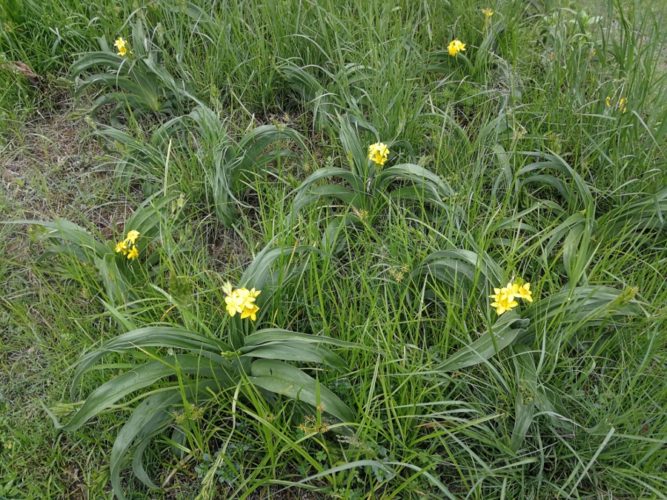The “African potato” (Hypoxis hemerocallidea) first rose to fame ~ or was it infamy ~ in 1997 when our then minister of health recommended it’s immune strengthening properties to patients with HIV and AIDS.
It turns out though that it was misnamed as it is in fact not a potato at all. Hypoxis hemerocallidea is a corm, which is compressed underground stem, developing vertically. It is not a tuber, which is a swollen stem, like the potato, developing horizontally.
It is one of the best known muti plants. Some years ago it was estimated that at least 62 000 to 170 000 individual bulbs were sold annually in the Witwatersrand markets alone. Land transformation and habitat loss is also a threat to the species.
The plant is extremely popular with traditional healers, so smallholders might consider growing it for this trade.
It is a beautiful tuberous perennial, synonymous with the grasslands, where its yellow star-like flowers herald the arrival of spring and summer rains. Hypoxis hemerocallidea is a hardy garden plant and originates from Southern Africa.
It occurs in a wide range of habitats, including sandy hills on the margins of dune forests, open, rocky grassland, dry, stony, grassy slopes, mountain slopes and plateaus. Provincial distribution includes Eastern Cape, Free State, Gauteng, KwaZulu-Natal, Limpopo, Mpumalanga and North West.
Description
It is a tuberous perennial with strap-like leaves and yellow star-shaped flowers. The leaves are up to 400 mm long, neatly arranged one above the other in 3 ranks, broad, stiff and arching outwards with prominent ribs and tapering towards the tips. The lower surface of the leaves is densely hairy with white hairs. Leaves appear above ground in spring before the flowers. It flowers from very early spring to midsummer i.e. August to April. Seeds are hard, black, smooth and glossy. The fruit is a capsule that splits across its diameter to expose the small black seeds.
Hypoxis hemerocallidea arises from a large dark brown corm which is covered with bristly hairs. The corm is bright yellow when freshly cut and has an unpleasant bitter taste.
The plant prefers full sunlight and well-drained soil.
Propagation of the plants is done from seed, tissue cultures and bulbs. If you already have the plant growing on your plot, seeds should be collected just before the capsules open. Remove old flowering stalks to encourage flowering. They can be treated with fungicide and boiling water before planting into compost-rich soil. Germination can take up to a year. Seedlings should be left for a year before transplanting.
For best results, seeds should be kept cold for six to eight weeks (mixed with vermiculite in the refrigerator) before sowing in well prepared seed boxes.
Seeds should be sown in early spring and should be planted 1mm deep and covered with fine grass compost.
Seeds are occasionally available from indigenous nurseries.
Other Methods of Growing African Potato
Corm division is a more rapid and successful method of propagating the plants. Plough the field into long rows of mounds.
One-year-old corms need less space to be planted (10 cm apart in rows and 20 cm between the rows). If the intention is to leave it to grow for more than three years, the spacing should be increased (20 cm apart in rows with 50 cm between rows) to accommodate the large size.
It is not necessary to use chemical fertiliser, however, as the corms will remain in place for some time, enrich the soil with a dose of compost or mulch a couple of times a year.

The soil should be kept moist, but not wet with good ventilation and low humidity. The plants should be irrigated weekly. Give the plants 25 mm of water per week for the first three months. In cool climates the plants must be kept dry during winter. The plant is extremely hardy and drought-resistant.
Unfortunately it is quite popular with termites and other pests such as American bollworm, spotted maize beetle, stink bug and grasshopper. Porcupines dig up the corms and centipedes eat the outer covering. Application of registered pesticides is recommended for most of the abovementioned pests.
Harvesting Hypoxis hemerocallidea
Harvesting the African potato takes place in summer when the plants are actively growing. Once the corms have reached a weight of 250 gm, harvesting can also happen throughout the year. A handpick method is used to harvest the plant.
Hypoxis hemerocallidea is fire-tolerant, and occurs widely in grassland where fire is part of the ecological regime. It is dormant during the fire season and re-sprouts after fire. The fibres protect the corm against fire damage. Fire promotes the growth of new leaves. Seeds are also stimulated to germinate by fire.
Bees and other pollinators visit the flowers.
The African potato is a very important medicinal plant that is used extensively in both traditional and western medicine. Traditional healers use it to treat delirium, diabetes, PMS and as a parasiticide. Conventional uses include application of a deep penetrating ointment to treat symptoms associated with arthritis, psoriasis and fibromyalgia. It is also beneficial against skin conditions such as eczema, acne, scars, burns, rashes, bed sores, warts, stretch marks, sunburn, insect bites and dry skin.
However Hypoxis also contains toxic substances in the raw form, and has not been registered with the Medical Control Council for that reason. Smallholders be warned: the raw products can be toxic and must be used with caution. It is recommended to use a shelf product as a safe alternative.
To read more on growing crops click here.
To receive all our notices and each edition of SA Smallholder register here.


Some pictures of the corms would be interesting!
Where can I buy seed to start planting.
Hi Ilse.
How many seeds are you looking for , and what price are you willing to pay ?
I may be willing to collect fresh seeds for you.
If interested you can contact me eiher on Whatsapp 0825057402 or email me at hartigheiner@gmail.com .
Kind regards . Heiner Hartig